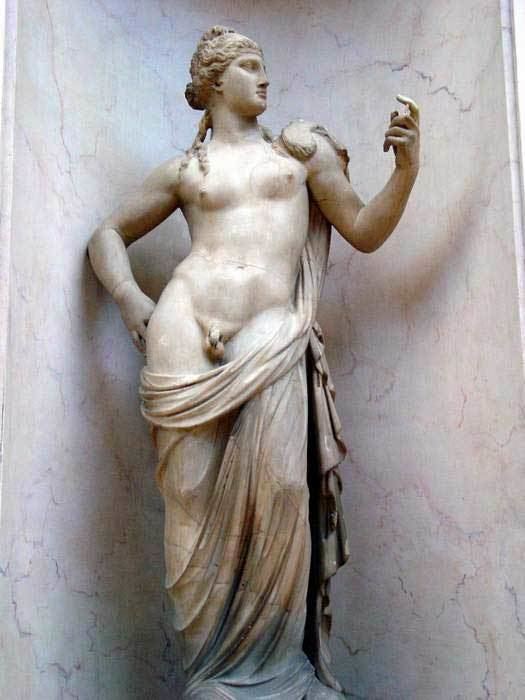 | ||
Similar Charites, Phaethon, Semele, Echo | ||
In Greek mythology, Hermaphroditus or Hermaphroditos /hərˌmæf.rəˈdaɪ.təs/ (Ancient Greek: Ἑρμαφρόδιτος) was the son of Aphrodite and Hermes. According to Ovid, he was born a remarkably handsome boy with whom the water nymph Salmacis fell in love and prayed to be united forever. A god, in answer to her prayer, merged their two forms into one and transformed them into an androgynous form. His name is compounded of his parents' names, Hermes and Aphrodite. He was one of the Erotes.
Contents
- Hermaphroditus
- Symbolism
- Mythology
- Cult and worship
- Literature
- Paintings and engravings
- Sculpture
- Music
- Film
- References
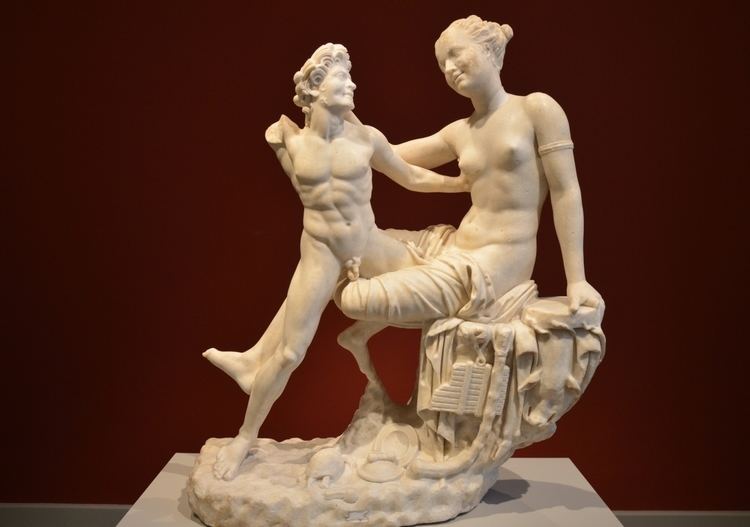
Because he was a son of Hermes, and consequently a great-grandson of Atlas, sometimes he is called Atlantiades (Greek: Ατλαντιάδης). Hermaphroditus' father, Hermes, was also called Atlantiades because his mother, Maia was the daughter of Atlas.
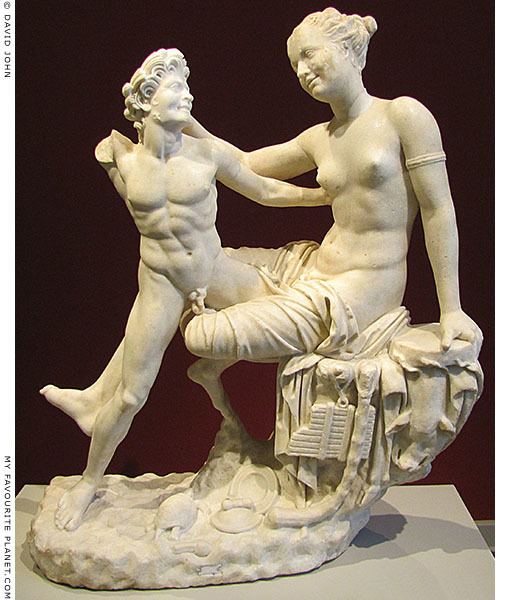
His name is the basis for the word hermaphrodite.
Hermaphroditus
Symbolism
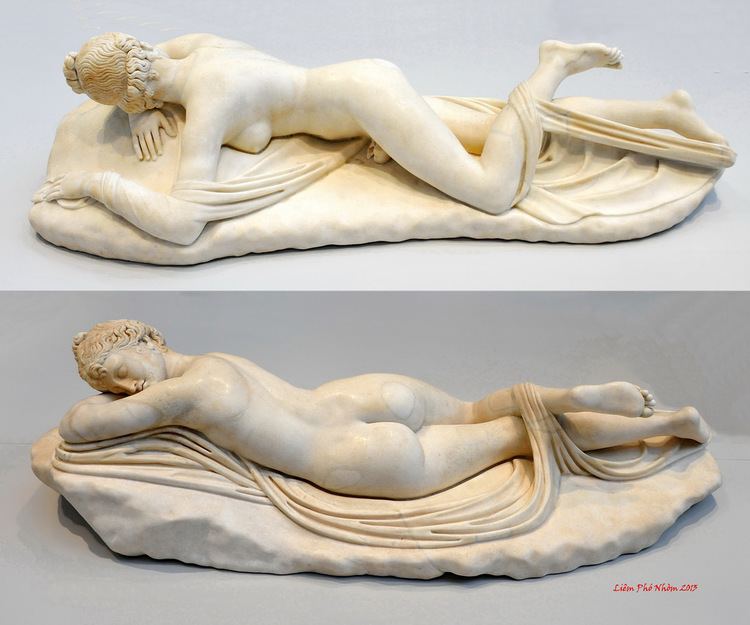
Hermaphroditus, the two-sexed child of Aphrodite and Hermes (Venus and Mercury) had long been a symbol of androgyny or effeminacy, and was portrayed in Greco-Roman art as a female figure with male genitals.

Theophrastus's account also suggests a link between Hermaphroditus and the institution of marriage. The reference to the fourth day of the month is telling: this is the luckiest day to have a wedding. Hermaphroditus's association with marriage seems to have been that, by embodying both masculine and feminine qualities, he symbolized the coming together of men and women in sacred union. Another factor linking Hermaphroditus to weddings was his parents' role in protecting and blessing brides.

Hermaphroditus's name is derived from those of his parents Hermes and Aphrodite. All three of these gods figure largely among erotic and fertility figures, and all possess distinctly sexual overtones. Sometimes, Hermaphroditus is referred to as Aphroditus. The phallic god Priapus was the son of Hermes in some accounts, and the youthful god of desire Eros of Hermes and Aphrodite.
Mythology
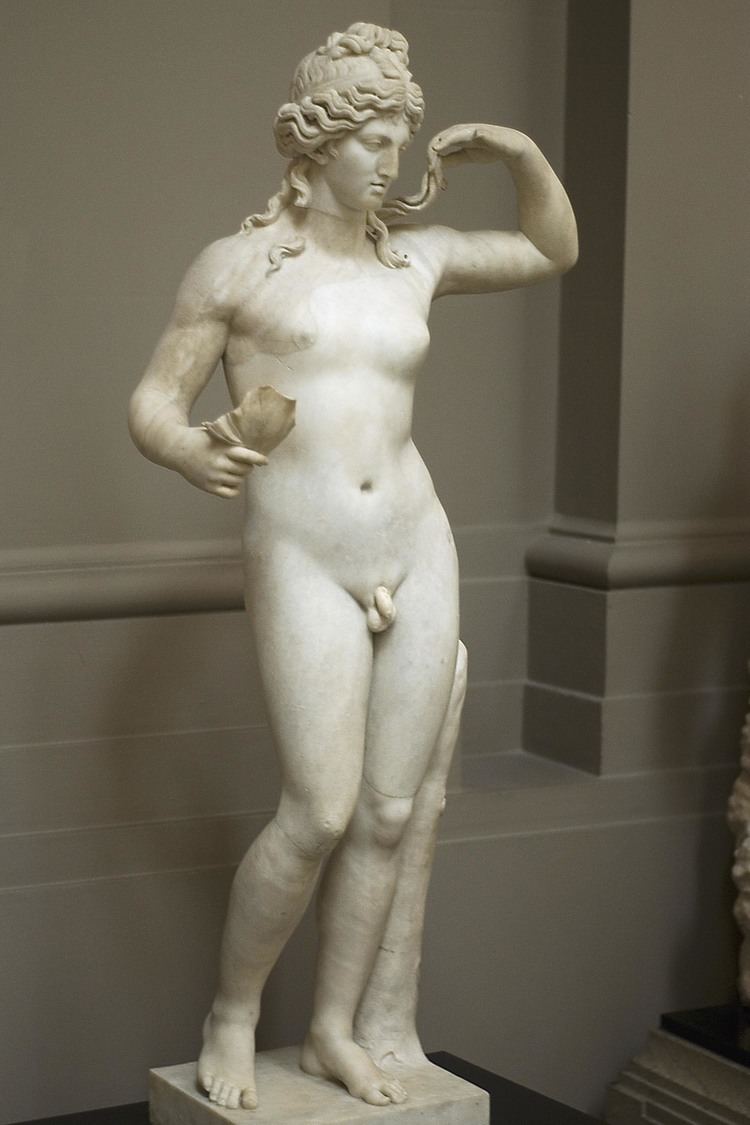
Ovid's account relates that Hermaphroditus was nursed by naiads in the caves of Mount Ida, a sacred mountain in Phrygia (present day Turkey). At the age of fifteen, he grew bored with his surroundings and traveled to the cities of Lycia and Caria. It was in the woods of Caria, near Halicarnassus (modern Bodrum, Turkey) that he encountered the nymph, Salmacis, in her pool. She was overcome by lust for the boy, who was very handsome but still young, and tried to seduce him, but was rejected. When he thought her to be gone, Hermaphroditus undressed and entered the waters of the empty pool. Salmacis sprang out from behind a tree and jumped into the pool. She wrapped herself around the boy, forcibly kissing him and touching his breast. While he struggled, she called out to the gods that they should never part. Her wish was granted, and their bodies blended into one form, "a creature of both sexes". Hermaphroditus prayed to Hermes and Aphrodite that anyone else who bathed in the pool would be similarly transformed, and his wish was granted. "In this form the story was certainly not ancient," Karl Kerenyi noted. He compared the myth of the beautiful ephebe with Narcissus and Hyacinthus, who had an archaic hero-cult, and Hymenaios.

Diodorus Siculus in his work Library of History mention, that some say that Hermaphroditus is a god and appears at certain times among men, but there are some who declare that such creatures of two sexes are monstrosities, and coming rarely into the world as they do have the quality of presaging the future, sometimes for evil and sometimes for good.
Cult and worship
The oldest traces of the cult in Greek countries are found in Cyprus. Here, according to Macrobius (Saturnalia, iii. 8), there was a bearded statue of a male Aphrodite, called Aphroditos by Aristophanes. Philochorus in his Atthis (ap. Macrobius loc. cit.) further identified this divinity, at whose sacrifices men and women exchanged garments, with the Moon. A terracotta plaque from the 7th century BC depicting Aphroditos was found in Perachora, which suggests it was an archaic cult.
The deification and the origins of the cult of hermaphrodite beings stem from Eastern religions, where the hermaphrodite nature expressed the idea of a primitive being that united both genders. This double sex also attributed to Dionysus and Priapus - the union in one being of the two principles of generation and conception - denotes extensive fertilizing and productive powers.
This Cyprian Aphrodite is the same as the later Hermaphroditos, which simply means Aphroditos in the form of a herm (see Hermae), and first occurs in the Characters (16) of Theophrastus. After its introduction at Athens (probably in the 5th century BC), the importance of this deity seems to have declined. It appears no longer as the object of a special cult, but limited to the homage of certain sects, expressed by superstitious rites of obscure significance.
We find in Alciphron that there was at Athens a temple of Hermaphroditus. The passage proposes that he might be considered as the deity who presided over married people; the strict union between husband and wife being aptly represented by a deity, who was male and female inseparably blended together.
Literature
The earliest mention of Hermaphroditus in Greek literature is by the philosopher Theophrastus (3rd century BC), in his book The Characters, XVI The Superstitious Man, in which he portrays various types of eccentric people.
The first mention of Hermes and Aphrodite as Hermaphroditus's parents was by the Greek historian, Diodorus Siculus (1st century BC), in his book Bibliotheca historica, book IV, 4.6.5.
Hermaphroditus, as he has been called, who was born of Hermes and Aphrodite and received a name which is a combination of those of both his parents. Some say that this Hermaphroditus is a god and appears at certain times among men, and that he is born with a physical body which is a combination of that of a man and that of a woman, in that he has a body which is beautiful and delicate like that of a woman, but has the masculine quality and vigour of a man. But there are some who declare that such creatures of two sexes are monstrosities, and coming rarely into the world as they do they have the quality of presaging the future, sometimes for evil and sometimes for good.
The only full narration of his myth is that of Ovid's Metamorphoses, IV.274-388 (8 AD), where the emphasis is on the feminine snares of the lascivious water-nymph Salmacis and her compromising of Hermaphroditus' erstwhile budding manly strength, detailing his bashfulness and the engrafting of their bodies.
A rendering of the story into an epyllion, published anonymously in 1602, was later (1640) attributed by some to Francis Beaumont.
In the Palatine Anthology, IX.783 (980 AD), there is a reference to a sculpture of Hermaphroditus which was placed in a bath for both sexes. The passage IX.317 is in dialogue form, based on the dialogue between Hermaphroditus and Silenus. The latter claims that he has had sexual intercourse with Hermaphroditus three times. Hermaphroditus complains and objects to the fact by invoking Hermes in an oath, while Silenus invokes Pan for the reliability of his allegations.
Algernon Charles Swinburne's poem "Hermaphroditus" in Poems and Ballads is subscribed Au Musée du Louvre, Mars 1863, leaving no doubt that it was the Borghese Hermaphroditus that had inspired his ode.
Paintings and engravings
Sculpture
Music
Film
A persona named 'Hermaphroditus' appears in the film Fellini Satyricon as a childlike, physically weak god who is able to heal human supplicants afflicted by various ailments but apparently unable to heal him/herself. Hermaphroditus is not mentioned in the original Petronius novel Satyricon, on which Fellini's film is loosely based. According to one source, the film episode "may be based on a Pseudo-Petronian poem sometimes printed along with the Satyricon".
